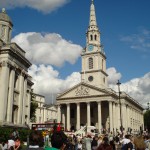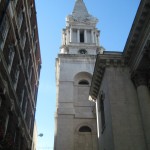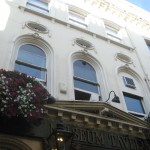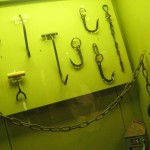Entries from August 2009
My first impression upon entering the National Gallery was skepticism that the art could possibly be any more beautiful than the building’s architecture. I’m not usually much of an art person (although I’m a HUGE Dalí fan), and I usually don’t spend much time in museums dedicated entirely to art. However, to my great surprise, I was abslutely fascinated by the thousands of paintings. Of course, I got to see paintings I thought I would only ever see in photos, such as Van Gogh’s Sunflowers and Monet’s Japanese Bridge. Additionally, I chose to make note of paintings I previously was unfamiliar with that caught my eye. Of these, my favorite was Louis-Léopold Boilly’s A Girl at a Window. The oil on canvas painting originally attracted me because it is painted to look like a framed still image; therefore, it is in black and white and rather unique. As I drew closer, I noticed the clarity of the details, especially those of the fish in the bowl next to the girl. The painting is so clear, it could easily be mistaken for a modern-day cartoon or CGI. Being a terrible artist myself, I never imagined a handcrafted painting could look so smooth and realistic.
While looking at the medieval collection of the Gallery, I noticed various paintings depicting the Biblical scene of St. Michael the Archangel defeating the Devil. Carlo Crivelli’s St. Michael (1476), Bartolomé Bermejo’s St. Michael Triumphant Over the Devil (1468), and Piero della Francesca’s St. Michael (1469) all portray St. Michael similarly. He appears as a rather young looking boy wearing medieval style armory. However, Francesca opts to give the archangel wings instead of a cape. The most noticeable difference to me, though, is in the way the artists chose to represent the Devil. Crivelli’s Devil resembles a lizard-like demon, whereas Barmejo’s Devil is smaller and much more cartoonish and almost comical when compared to the triumphant St. Michael. Francesca’s is once again different from the other two, as he portrays the Devil as a simple serpent in the corner of the painting, which focuses on the archangel instead. These paintings fascinated me because of their diversity. I always knew styles of art changed over time, but I never really considered the diversity that could exist between the contemporary artists of a time period. Seeing these three paintings that show the same subject painted within a few years of one another helped me to appreciate the different ways in which artists might imagine their subjects.
Tags: Museums · Sarah
“Slavery, The Scale of Freedom” by Owen. “These scales show how hard it was and can be to achieve liberty and justice when fighting for freedom” reads the sign. The scale, the representation of inequality frightens me.
An introductory passage in the museum describes the need for us to restrain from using historical terms such as “Negro” and “Mulatto” which were derogatory terms during slavery. I think back to the time when in I resided in Azerbaijan, my college-educated parents and friends would refer to anyone who is of a mixed ethnicity as a “mulatto” which now I know is originated from the word “mule.” And when African American men in United States refer to each other as “Negros” in a “joking” manner. Or when the abolition of slavery in East Indies occurred, the government found a new source of cheap labor in India resulting with 1,500,000 Indians being subjected to the system. Reading novels such as Saalam:Brick Lane, West Indian and South Asian communities are still feeling the effects of abuse put upon them by those who were in a place of power.
Upon visiting the atlantic transatlantic slavery exhibition questions arose: Is freedom truly achieved in England and around the world? Are the facts presented at Docklands Museum part of the past or present (as in certain actions by those in power limit actions of those who have less power)? If my liberal, educated family used a derogatory term “Mullato” and did not even realize how much hurt it held behind it, how do we further educate on the topic of slavery and how much more there is behind it?
With the mixed reviews posted by the museum visitors at the end of the exhibition, I couldn’t help but question the British education system. With the comments ranging from acceptance and understanding to guilt and criticism, I wonder how comfortable the British are with their history and how much they discuss in their secondary school regarding the British participation in transatlantic slavery.
It frightens me that without education, dialogue, and willingness to change and accept the cycle will continue and a new group and culture will suffer from injustice. Words such as “Mullato” and “Negro” will be spoken and “Scales of Freedom” will never reach a balance.


Tags: Jeyla · Museums
August 25th, 2009 · 1 Comment
As I sit and write this blog post, I am listening to Claire De Lune by Debussy.
How beautiful it is, that music has the ability to bring people together, regardless of race, religion, or nationality. During the concert today, I became very fascinated with the ability to believe something to be universal. How can such a large group of people enter a Christian church, in no means looking for religion, to attend a performance by an unknown group, that solely relies on ones ability to hear. Can such an art form unite human beings? Do we have the knowledge to accept the fact that people of this world have more in common than we think, or are we too busy promoting our differences? Is peace a possibility in our future? I’m not sure, however I do believe that music is a beautiful representation of how people of the world can connect no matter the differences.
I feel like I say this every time I write a blog, but how could my day start any better. I absolutely loved watching E.L.F perform. Their first piece, which was an abridged version of the Broadway Musical “Phantom of the Opera”, was one of the most moving experiences I have had here in London. To be in such a historical building, and to watch these passionate individuals perform, was truly a beautiful site.
After the performance I headed towards the National Gallery Museum. Not only did I about wet my pants at the size of the museum, but as I walked further towards the entrance the view from its steps became more and more beautiful. Many of London’s great land marks were right in front of my eyes. “Unbelievable” is the only word i can use to describe what I saw. The Museum was what I expected and more. I have a particular interest in Rembrandt and other Dutch artists, and i think it is because of my obsession with early modern Europe. Rembrandt painted during the 16th century when Holland was a very important economic country. It is a wonderful example of how Europe was evolving over the 15th-18th centuries but still remained a central area for the arts. I really enjoyed this museum. I made it through many of the galleries but I would love to go back and spend more time in each section.
It was a wonderful day. I wake up every morning in shock that I’m lucky enough to be here. I hope every step I take reflects how grateful I am to be here. I LOVE IT!
Tags: Museums · Patsy
On our way yo St. Martin in the Field we ran into an wonderful violinist in the Tube. Each of us in the group dropped some of our excess change into his violin case and went on our way. At that point we did not realize what was waiting for us at St Martin’s. After taking our seats the E.L.F. Trio began to play and all of us were completely blown away! I find it mind boggling that such an AMAZING concert could be free open to the public.
We then all headed over to the National Gallery. The National Gallery was also free, so we all got to see Rubens, Di Vinci, Turner (my favorite), Monet, and Van Gogh for FREE. The longer I am here the more I am impressed by the extent to which London embraces and supports the arts. There are free concerts everywhere, all the time, and extrordinary people simply playing in the street or in the Tube. I would move here in an instant, if givin the chance and lets face it the finances, simply for the arts.
Tags: Rebecca
Upon entering Saint-Martin-in-the-Fields, early this afternoon for the E.L.F. trio, I thought I had a pretty good idea of what to expect from the concert and the church. I’ve been in a good number of European churches, and I admit that I’ve gotten a bit jaded on the church front. I wasn’t surprised by the decor of the church (Corinthian columns, gilded decoration, chandeliers, etc). It was quite typical of a church built in the mid-1700s. I was, however, quite enthralled by the window over the main altar of the church. Unfortunately, I couldn’t take a picture of it from the church, but it seemed to be purposely distorted into a display of modern art and it certainly made an interesting juxtaposition with the existing 18th century decor and architecture. (I was unable to find more information to tell if it is an original piece of the church or a more recent addition.)
The E.L.F. trio also managed to surprise me greatly! As much as I enjoyed it, I was notexpecting a 35 minute long tribute to Andrew Lloyd Webber’s Phantom of the Opera! Anyone else have an overwhelming desire to listen to the Phantom soundtrack after that?
The National Gallery was probably the highlight of my day. Anyone who knows me really well can tell you that I love music and theatre, but I’m not one much for old paintings. We were told that when we go to the British Museum we should keep in mind how the different artefacts relate to Great Britain. Along those same lines in the National Gallery I couldn’t help but keep thinking about how the paintings managed to get to London. The ones that were by British artists or of Britain or by an artist from the Empire made sense, but how did they get such a large number of paintings from Germany, the Netherlands, Italy, etc.? What really shocked me were the 13th to 15th century paintings that used to be altarpieces in churches. There was one by Filippino Lippi, called The Virgin and Child with Saints Jerome and Dominic, from about1485 that was painted for San Pencrazio church in Florence. How did these pieces of art from the walls of churches manage to get to London? I just had a bit of an issue getting my head around the idea that so many of these fragile pieces of artwork were cut up and shipped to London museums from places that were outside of Britain’s sphere of influence.
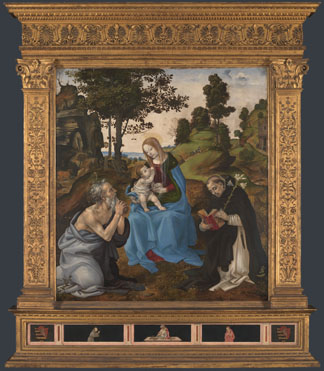
The Virgin and Child with Saints Jerome and Dominic by Filippino Lippi - picture taken from the website of the National Gallery
As I said above, I am not one who is a big fan of looking at old paintings for hours on end, but I know the big names and can recognize my fair share of famous paintings. One of the things I appreciated and was in awe of most about the National Gallery was the sheer volume of paintings they had that I was familiar with. There was one room with twenty-one paintings on the walls and I counted nine by Raphael and two by Michelangelo. (I came to realize that you could tell where a really famous painting or artist’s work was when there was a massive group of people surrounding it and traffic stopped flowing.) The US has some really nice art museums, but the content of the National Gallery blew my mind.
The main thing I learned today is that art and music transcend all language barriers. I probably heard people speaking at least a dozen different languages when I was strolling around the National Gallery and sitting in Saint-Martin-in-the-Fields, but it didn’t matter because everyone can enjoy art and it is completely open to interpretation.
Tags: Kelley
Today’s class centered around a discussion of how immigrant and minority populations in London have either struggled or been able to assimilate. We examined specific groups and religions and attempted to define exactly what assimilation entails. Kelley brought up a great point about how some groups that come to London have no interest in assimilation. They come simply to get an education, make some money and share what they’ve learned once they return to their country of birth. This complicates the assimilation process even more. What can we do as educated young people to help minority groups achieve assimilation? Do they want our help at all? These are some questions I am going to continue to wrestle with for the remainder of my time in the U.K.
After class today I had an afternoon filled with art, both musical and visual. A lunchtime concert at historic St. Martin in the Fields featured a fantastic three man ensemble called E.L.F. Made up of a pianist Geoff Eales, french horn player Dave Lee and flautist Andy Findon the group put on an incredible performance highlighted by an extraordinary 40 minute take on Andrew Lloyd Webber’s “The Phantom of the Opera”. The music was moving and captivating throughout and at the end of “All I Ask of You” I was left with goosebumps from head to toe. As someone who played trumpet and a little bit of French Horn throughout high school I was amazed by the richness of the sound Mr. Lee produced. It was superior to anything I had ever heard performed in the past. The church’s incredible acoustics certainly had a major impact on the groups resounding sound as well turning a three man ensemble into what sounded like a full fledged orchestra. One action that took place during the concert that Brandon and I were pondering was whether it is customary for performers to exit the stage completely while the audience applauds and then return for the next number shortly after. We were unsure if this was something unique to England, unique to St. Martins in the Fields or whether the group chose to do so at their own discretion. In any event it was something we had never seen before.
After the concert Aidan, Brandon and I headed over to the National Gallery where we gazed at thousands of works of art from all different countries and time periods. I do not know much about visual art and what techniques are used to make paintings considered great but I was continually amazed and impressed by the amount of detail these artists put into their work. Even the smallest stroke of a paintbrush can change a painting entirely. We spent a number of hours inside the National Gallery gazing at everything from Van Gogh to Manet to Van Brugh. Visual art is not my forte nor my specialty but I was very impressed and would go back to the museum in a heartbeat.
After our tour of the National Gallery we headed back out to Trafalgar Square. The rain had let up and the square was alive with all kinds of people. There was protesting, dancing, singing and any number of exciting things going on. We took an abundance of pictures while in the area, attempting to catch all the excitement that was taking place as well as capturing the various monuments in the area such as Nelson’s Column and St. Martin in the Fields.
The final stop in our afternoon included a tour of the National Portrait Gallery, just down the road from St. Martin in the Fields. Inside we viewed portraits of everyone from Princess Diana to T.S. Eliot. My favorite part of the portrait gallery was the section they featured on the Bloomsbury Group. Portraits of Virginia Woolf, E.M. Forster and Lytton Strachey just to name a few were found inside this area. After going on the Bloomsbury walk the day before with Professor Qualls the information was still fresh in my mind and I was able to make connections between the tour and the exhibit. This was fascinating.
I can safely say that this has been my favorite day in London so far. A stimulating discussion, an unbelievable concert, a walk through an internationally recognized museum and time spent with friends adds up to a wonderful and busy day. I hope that the rest of our time spent in London will follow suit.
Tags: Churches and Cathedrals · Henry · Museums
This Sunday in London the Humanities group went on a walking tour of the Tower Hill and a designated area of London built by the Romans (i.e the roman wall). The beautiful architecture seemed so distinct to London, because of this sense of organized chaos of defined by the Roman architecture mixed with the modern. Of all the places that I have ever been to in my short lifetime London buy far has the most character. London has no structure as to what any given area must look like, instead a person traveling the city would view a very diverse array of structural design, and although not in harmony with the “look” of London, still manages to define the personality of London.
As we walked the tour I could not help but compare the diversity within the building design to that of the people and different cultures that inhabit London. Being completely unaware of what the structure and the faces of London would like, I was completely surprised to see how similar in diversity London was in comparison to a large metropolitan area like New York, Chicago, or Los Angeles. People from all different regions of the world all together in one area is something I am used to seeing from where I come from, so coming to London and witnessing this same phenomenon of integration, however surprising, provided me with a sense of comfort because of how normal it felt.
However, as I mentioned before the major difference from major cities in America and perhaps most of the major cities in the world in comparison to London is the architectural structure and the randomness that is London. It is not uncommon to walk the streets of London to see a Cathedral or monument next to an insurance firm or a modern day office. Nor is it out of the norm to see a Starbucks located inside a historical monument. This theme of organized chaos that makes up this amazing city is one that is unique to that of any other place in the world, and makes me love it that much more.
However while walking through the tour of the London wall, and having read the history of London, I was surprised that I had not heard of the negative history of London. I pondered why I had not learned of London’s dark history, specifically the slave trade, and London’s role in it. Luckily later that afternoon my group visited the Docklands museum, where my curiosity would not only be satisfied, but educated.
On the top floor of the museum just past the first exhibit lies, the London African slave trade. When I tell you that this was one of the most amazing exhibits I had ever had the privilege of entering, I am only describing about 10% of how surreal this experience was. Having always learned about the slave trade as being an international event, I had only delved my knowledge to the America’s experience of it. So to actually learn about one of the world superpowers who participated in this inhumane portion of history made me challenge my views of what I had learned previously. In the exhibit they made it a point to express to the audience why they chose certain word’s in the exhibit and explained the history of the words so that the audience was able to get a sense of how important language is in this system of oppression that is slavery.
This experience has taught me so much about the world, and that there is so much more to learn. I feel so blessed to be in a position to get to learn about the world and its many different cultures in a way that others only get to dream about. I will cherish these moments forever!
Tags: Anthony · Uncategorized
August 25th, 2009 · 1 Comment
Greenwich Adventures-August 21
I woke up this morning feeling a bit overwhelmed by the amount of activities and travel planned for the day, but immediately felt at ease as we made our way to the Thames River embankment. I enjoyed watching the scenery and different types of architecture pass by as we made our way to Greenwich, and definitely felt like a tourist while taking what seemed like hundreds of pictures of Big Ben. Since I spend much of my summers in parks in New Jersey, I felt comforted by being in what seemed to be a familiar place to me. The walk helped to wake me up as well
I was most interested by the museum dealing with the creation and use of early clocks on ships. It truly amazes me that people were able to construct such intricate and elaborate instruments by hand, without the aid of computers or modern technology. I also laughed when I read that early ships planned to calculate their position in relation to other ships by firing a rocket exactly 6440 feet in the air at exactly 12am..it seems silly, but I suppose without clocks or ways to calculate latitude/longitude, it seemed logical. I feel rather inadequate when I realize that I would have absolutely no idea how to even begin to create something like these clocks from scratch, from the plans to making the parts to the actual collaboration and execution of the instrument. I’m also impressed that sailors trusted the instruments enough to actually use them while in the middle of the ocean. I know I would be nervous about being the first one to use something so important to my travels and, in essence, vitality.
I also enjoyed the planetarium and was quite amused by the man running it. Despite the presentation’s humorous aspect, I left feeling like an insignificant part of an infinitely larger being. Although I had learned about the solar system and galaxies in elementary school, I don’t find much use revisiting that information with my English and psychology majors. I liked connecting the passage of time with the movement of planets, stars, and the expansion of space in general. While some of the information was jarring, it was certainly useful and thought provoking.
Tags: Amy · Uncategorized
August 24th, 2009 · 1 Comment
It is hard to believe that a century ago, London was the center of the world of the international trade of physical goods. Not only was the London area one of the most productive manufacturers of goods in the world, but the London harbor was likely the single most important hub for international trade. It should probably come as a shock then that the London today deals with a fraction of a percent in goods that it once did. When I took visited the tour to the Docklands museum, I was struck by an extreme nostalgia for the London and also Great Britain that was actively engaged in the world market. While there were things that the British were not proud of (the list of all the slave ships that passed through London with the names of their owners and contributors was especially powerful), there was definite evidence that there was more than one British person who was disappointed with the London of today. In one corner of the exhibit, there was a map of the global trade routes that also indicated those that were most in use. In the center of the map (thanks to the British discovery of Longitude), sat London, the center for all of these goods being shipped from around the world. It should come as not shock then, when authors such as A.N. Wilson are openly hostile to the London of the 21st century, kept afloat by its massive tourist market.
Tags: Paul
August 24th, 2009 · 1 Comment
Yesterday, we took a walking tour around Bloomsbury, the neighborhood that is adjacent to our own. Learning about the area was truly fascinating, and I felt so lucky to have the opportunity to see where Virginia Woolf lived, walk along the sidewalk where Charles Darwin might have walked, and experience an area that is so rich in history.
We learned that in this one small area lived; Charles Dickens, The Bonham Carters, Edgar Allan Poe, Ralph Waldo Emerson, Thomas Hodgkin, Henry James, Charles Darwin, Virginia Woolf and T.S. Eliot. In fact, we saw a building that once housed the publishing company where T.S. Eliot worked, and were told of how his wife – whom Eliot claimed was mentally unwell – would “picket” outside the building with a sign that read “I am the abused wife of T.S. Eliot!”
We walked though an area around Russell square which was destroyed during the Blitz and rebuilt years later. It was interesting, too, to see just how severe the destruction of the city was at the Docklands Museum today. The rest of the museum was very informational, as well. I particularly enjoyed the sections about the docklands themselves. Being a visual learner, I found it very useful to see all the diagrams, primary sources of life at the Docklands and other visual and kinesthetic aids that connected with our readings. In particular, I remember one of the articles mentioning how dangerous working at the docks was; how many men were killed by falling into the storage areas below deck or suffering other serious injuries. After seeing some of the chains, hooks, and other tools used by the workers, I can really see just how dangerous working on the docks was.
Attached are some pictures both of the Bloomsbury walk and the Docklands Museum…
Tags: Anya · Museums






